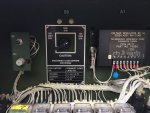Anyone trying to figure out how to "drop a ground rod", it's easy. Good videos on making a ground rod water drill on youtube.
You buy a 5/8" female hose adapter and a 10 foot length of conduit. Tap the adapter into the conduit. Wrap tape around conduit at 2' 6" from hose end. You can also cut about 1/2" off the other end, cut and flatten it out and silver solder it into the end lengthwise to help divert water to the sides.
Here's the cool part. Connect a garden hose, climb up on a ladder maybe 5-6' while water's running, press end to ground and keep pressing.
I drilled 3 ground rod holes in rocky ground in less than 5 minutes a few years back to ground my ham radio antenna tower (hexbeam), used it again later at a friend's, used it to set ground rod for electric fence. Net cost about $12, I recall.
Question I've got is, while the amperage rating on this unit is 52A at 120/240 1 phase, SURGE is what I'm most concerned about if I'm installing a breaker inside the genset (closest to the source), while my power distribution box has 20 and 30A breakers for 120 and 240 1 Ph outlets, the extra insurance seems reasonable.
I'm reading so much here about 80% vs 100, 110%, 120% rating, calculated 12,500 watts continuous, but how high a surge to expect from, say, a two-ton HVAC system (I don't own yet, and mfrs are a little sketchy on some of these details).
Is a 60A double-pole breaker too small? Just right?
Thanks in advance.
Norm


